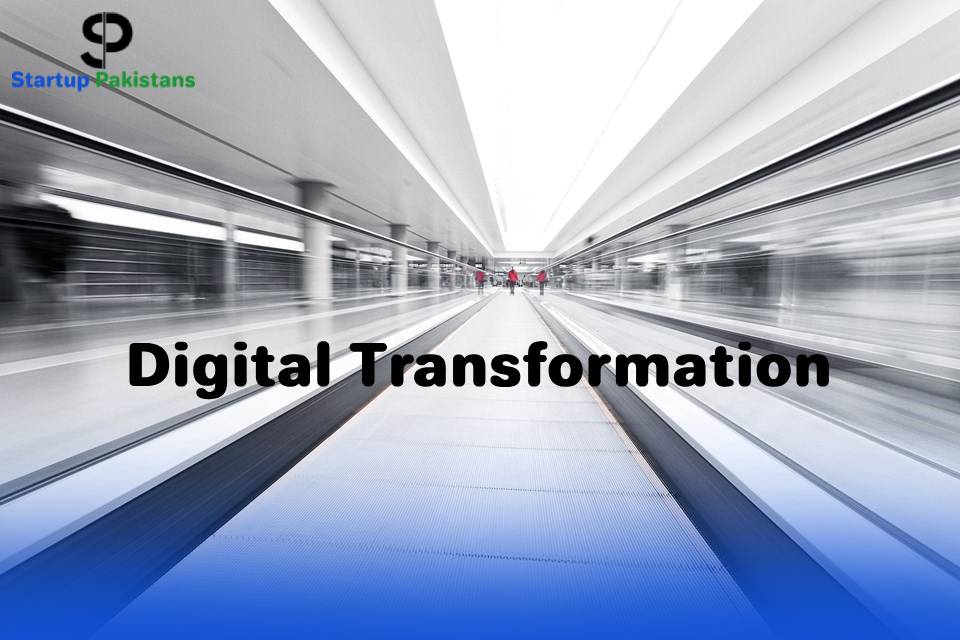Digital transformation utilizes digital technologies to alter how businesses operate fundamentally, provide value to customers, and interact with various stakeholders. It entails incorporating new technologies and reconsidering existing business models, processes, and strategies to leverage digital technologies’ power for growth, innovation, and efficiency.
Digital Transformation Initiatives/Activities
Digital transformation incorporates numerous initiatives and activities, given below:
Digitizing Processes:
The conversion of analog or manual processes into digital formats expedites operations, increases productivity, and reduces costs. This may involve outsourcing duties, deploying digital workflows, and utilizing digital tools and platforms.
Data-driven Decision-Making:
Utilizing data analytics, machine learning, and artificial intelligence to extract insights from vast quantities of data. This allows businesses to make informed decisions, recognize patterns and trends, personalize consumer experiences, and optimize operations.
Customer-Centricity:
Consumer-centricity entails a concentration on understanding and satisfying consumer requirements via digital channels. This includes augmenting consumer experiences, personalizing interactions, and offering self-service options via websites, mobile applications, social media, and other digital touchpoints.
Agile and Flexible Operations:
Leveraging agile methodologies and technologies to facilitate rapid experimentation, innovation, and market-specific adaptation. This requires nurturing a culture of perpetual improvement and empowering workers to collaborate and innovate.
Ecosystem and Partnership Development:
Collaborating with external partners, suppliers, and customers to develop ecosystems with added value. This may involve collaborating with entrepreneurs, utilizing digital platforms, and developing new business models based on partnerships and alliances.
Digital Skills and Talent Development:
Developing an organization’s digital capabilities by upskilling or recruiting individuals with the necessary digital skills. This ensures the workforce can utilize digital technologies effectively and drive the transformation process.It is not limited to the implementation of specific technologies. Rather, it necessitates a comprehensive strategy considering the entire organization and its constituents. It is a strategic initiative to promote innovation, competitiveness, and long-term viability in the digital age.
Four Primary Components of Digital Transformation?

The concept of digital transformation incorporates diverse aspects of organizations and operations. While there is no universally agreed-upon classification of the four primary areas of digital transformation, the following areas are generally acknowledged as essential components:
Digital Transformation of Business Processes:
This domain concentrates on reimagining and redesigning fundamental business processes to use digital technologies. It involves automating manual processes, streamlining workflows, and enhancing efficiency and productivity with digital tools and technologies.
Customer Experience Transformation:
In the digital age, customer expectations have shifted, and organizations must adapt to meet them. Enhancing interactions and customer engagement through digital channels, personalization, self-service options, and seamless omnichannel experiences are all part of the customer experience transformation process.
Digital Transformation of Data and Analytics:
Data has become an organization’s strategic asset, and effective data utilization is essential for digital transformation. This field entails the accumulation, analysis, and interpretation of data in order to obtain actionable insights, make decisions based on data, and drive innovation. Implementing advanced analytics techniques, such as artificial intelligence and machine learning, to derive value from data is also included.
Digital Transformation of Technology and Infrastructure:
Digital transformation requires a solid technological foundation. This domain entails modernizing IT infrastructure, employing cloud computing, instituting cybersecurity measures, and incorporating emergent technologies such as the Internet of Things (IoT), blockchain, and edge computing. In addition, it involves assuring the scalability, flexibility, and agility of the technology infrastructure to support digital initiatives.
Digital transformation is a complex and multidimensional process that can vary by industry, organization, and specific objectives. These four areas offer a comprehensive framework for understanding the essential elements of digital transformation. However, other factors, such as organizational culture, talent development, and change management, are also critical to the success of digital transformations.
Five Components of Digital Transformation?
A successful digital transformation typically entails multiple elements that drive organizational change and innovation in concert. Despite the fact that there is no one-size-fits-all strategy, the following five elements are typically associated with successful digital transformation initiatives:
Leadership and Vision:
Strong leadership is essential to establish the direction and vision for digital transformation. Leaders must comprehend the potential of digital technologies, articulate a distinct vision of the future, and advocate the organization-wide transformation. They should also prioritize investment in digital capabilities and cultivate an innovation-friendly culture.
Consumer-Centered Approach:
A comprehensive comprehension of consumer requirements and preferences should drive the digital transformation. Successful organizations place their customers at the center of their transformation initiatives, leveraging digital tools and technologies to enhance customer experiences, increase engagement, and deliver personalized products and services. This customer-centric strategy enables organizations to remain competitive and adaptable in the digital age.
Agile and Adaptive Culture:
Traditional hierarchical and isolated organizational structures can impede digital transformation. Organizations must cultivate an agile and adaptable culture that values experimentation, collaboration, and continuous learning to succeed. This requires empowering employees to take risks, fostering cross-functional teams, and fostering a growth mindset. Organizations can quickly adapt to changes and capitalize on emergent opportunities thanks to a culture of innovation and flexibility.
Integrated Digital Technology Infrastructure:
Digital transformation necessitates a robust technology infrastructure that supports the organization’s objectives and enables the integration of diverse systems and processes. This may entail utilizing cloud computing, data analytics, artificial intelligence, Internet of Things (IoT), and other digital tools to automate processes, acquire insights, enhance decision-making, and increase operational efficiency. A well-designed and integrated technology architecture supports successful digital transformation initiatives.
Decision-Making Informed by Data:
Data is a valuable asset for digital transformation. Organizations must establish a culture of data-driven decision-making in which data is gathered, analyzed, and used to inform strategies and drive innovation. Implementing advanced analytics capabilities, utilizing artificial intelligence and machine learning algorithms, and ensuring data governance and security are required. By harnessing the power of data, organizations can make more informed decisions, identify trends, optimize operations, and create personalized customer experiences.
Successful digital transformation is an ongoing journey that requires continuous adaptation and evolution; it’s important to note this. These elements provide organizations with a foundation for navigating the complexities of digital transformation and achieving long-term success in the digital age.
Which Five Ds comprise Digital Transformation?
The 5 Ds of digital transformation refer to a framework that highlights critical areas of focus for organizations embarking on a voyage of digital transformation. Depending on the source, the specific terminology or framework may vary, but the following elements are typically included:
- Discovery:
Understanding the present condition of the organization, including its processes, systems, and technologies, is the objective of this phase. It also involves identifying the digital transformation initiative’s aims and objectives.
- Design:
During the design phase, organizations create a digital transformation roadmap. This involves visualizing the desired future state, identifying the required changes, and developing strategies and plans to achieve the transformation objectives.
- Development:
Digital transformation initiatives are implemented during the development phase. This may involve the implementation of new technologies, the redesign of processes, the development of new applications or software, and the integration of systems.
- Disruption:
In this phase, the changes and innovations developed in the preceding phase are implemented throughout the organization. This may involve employee training, change management, and seamless transition to the new digital solutions.
- Data:
The data phase uses data and analytics to generate insights and decision-making. This involves accumulating, analyzing, and interpreting data from multiple sources in order to obtain actionable insights that can optimize processes, enhance consumer experiences, and drive business growth.
While the 5 Ds provide a valuable framework, it is important to remember that digital transformation is continuous and iterative. Continuous adaptation, monitoring, and refinement are required to keep up with the swiftly evolving digital landscape and shifting business requirements.
Fundamental Objective of Digital Transformation?

The primary objective of digital transformation is to utilize digital technologies to alter how businesses operate profoundly, provide value to customers, and remain competitive in the digital age. Digital transformation entails adopting and integrating diverse digital technologies, such as cloud computing, big data analytics, artificial intelligence, the Internet of Things (IoT), automation, and other emerging technologies, into various aspects of an organization’s processes, systems, and culture.
The principal objectives of digital transformation are as follows:
Enhancing Customer Experience:
By leveraging digital technologies, organizations can provide customers with personalized, seamless, and expedient experiences across multiple touchpoints, including websites, mobile applications, social media, and other digital channels.
Improving Operational Efficiency:
Improving operational efficiency: Digital transformation enables organizations to automate manual processes, streamline operations, and optimize resource utilization, resulting in higher productivity, lower costs, and a quicker time to market.
Enabling Data-driven Decision-making:
By harnessing the power of big data and advanced analytics, organizations can obtain insights from enormous quantities of data, make data-driven decisions, and identify new business opportunities.
Empowering Employees:
Digital transformation provides employees with the tools and technologies necessary to collaborate, communicate, and work more efficiently, regardless of location. It promotes a more adaptable and agile workplace.
Innovating Business Models:
Digital transformation offers new opportunities for developing innovative products and services, investigating new revenue streams, and disrupting conventional business models. It enables organizations to remain ahead of the competition and adapt to the constantly changing market dynamics.
Ensuring Business Resilience:
By adopting digital technologies, organizations can develop greater resilience to disruptions such as economic downturns, natural disasters, and unforeseen occurrences such as the COVID-19 pandemic. Remote work, remote service delivery, and adaptable operations are made possible by digital transformation.
It is important to note that digital transformation is not only about implementing technology but also involves organizational change, cultural adjustments, and a strategic approach to leverage digital capabilities throughout an organization. To thrive in the digital era requires leadership, collaboration, and a mindset centered on continuous innovation and adaptation.
Primary Characteristics of Digital Transformation?
Digital transformation comprises various features and components that organizations employ to leverage technology and create substantial changes to their business models, processes, and consumer experiences. There is no definitive list of characteristics associated with digital transformation, the following are some of the most prominent ones:
Technology Integration:
Integration of advanced technologies such as artificial intelligence (AI), machine learning, the Internet of Things (IoT), cloud computing, big data analytics, and automation into various aspects of an organization’s operations is known as digital transformation.
Data-driven Decision-making:
Data-driven decision-making: Organizations utilize data to obtain valuable insights, make informed decisions, and drive innovation. To identify trends, consumer preferences, and operational inefficiencies, they collect, analyze, and interpret large volumes of data.
Enhanced Customer Experience:
The objective of digital transformation is to provide customers with seamless, personalized, and expedient experiences across all channels and touchpoints. This includes engaging and interacting with customers via digital platforms, mobile applications, self-service portals, chatbots, and social media.
Agile and Collaborative Culture:
Digital transformation promotes an agile and collaborative culture within organizations. It encourages cross-functional teams, iterative processes, experimentation, and continuous learning in order to respond to changing market conditions and customer requirements.
Process Automation and Optimization:
Automation plays a key role in digital transformation, allowing organizations to streamline and optimize their processes. Robotic Process Automation (RPA) and other automation tools eradicate manual and repetitive duties, boost productivity, and minimize human error.
Infrastructure that is Adaptable and Scalable:
Digital transformation frequently requires an organization to upgrade or reconfigure its IT infrastructure to support the adoption of new technologies. This may involve the migration to cloud-based solutions, the implementation of scalable architectures, and the implementation of cybersecurity measures.
Innovation and Agility:
A culture of innovation and agility is fostered by digital transformation. Organizations actively pursue new ideas, experiment with emergent technologies, and embrace change in order to maintain a competitive advantage in the marketplace and meet changing consumer needs.
Data Security and Privacy:
As organizations acquire and manage vast data, ensuring data security and privacy becomes increasingly important. Digital transformation focuses on instituting robust cybersecurity measures, adhering to data protection regulations, and protecting sensitive consumer data.
Collaboration within the Business Ecosystem:
organizations are increasingly collaborating with partners, suppliers, and other stakeholders. Digital transformation encourages the integration of diverse actors in order to create value, drive innovation, and provide customers with comprehensive solutions.
Continuous Learning and Skill Enhancement:
Digital transformation requires employees to acquire new skills and acclimate to ever-changing technologies. To enable their personnel to flourish in the digital era, businesses invest in training programs, upskilling initiatives, and a culture of learning.
It is important to note that digital transformation is a dynamic and ongoing process. The features and priorities may vary based on the industry, organization, and specific goals.



 Pakistan eCommerce Association Hosted the Global Digital Awards 2025 Powered by Delogics
Pakistan eCommerce Association Hosted the Global Digital Awards 2025 Powered by Delogics  Trump’s 155% Tariff Threat to China Hits Global Markets | Analysis by Mujeeb UR Rehman
Trump’s 155% Tariff Threat to China Hits Global Markets | Analysis by Mujeeb UR Rehman  <strong>Mujeeb UR Rehman Joins Global Web3 Leaders with Crunchbase and EverybodyWiki Profiles</strong>
<strong>Mujeeb UR Rehman Joins Global Web3 Leaders with Crunchbase and EverybodyWiki Profiles</strong>  Mujeeb UR Rehman: Top Pakistani Web3 Growth Strategist Featured on Binance and Gate.com
Mujeeb UR Rehman: Top Pakistani Web3 Growth Strategist Featured on Binance and Gate.com  Pakistan’s E-Commerce Future Faces Threats from New Taxation Policies
Pakistan’s E-Commerce Future Faces Threats from New Taxation Policies  IMPACT 2025: AI, E-commerce & Wellness Summit in Karachi Empowering Women and Students
IMPACT 2025: AI, E-commerce & Wellness Summit in Karachi Empowering Women and Students